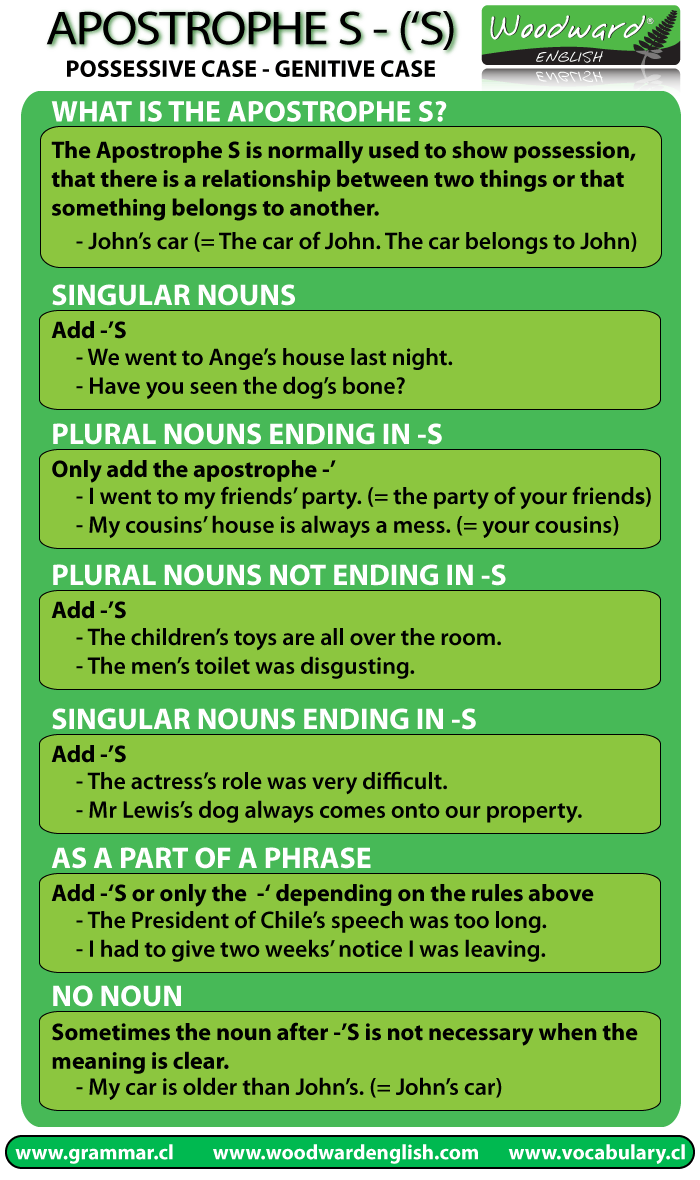The Apostrophe S - ('S)
Possessive Case - Genitive Case
Also called the possessive case, the genitive case is when we add apostrophe S (’s) to show possession, that something belongs to another or a type of relationship between things.
e.g. Woodward’s house, Your brother’s friend
The meaning of X’s Y is:
= The Y of X
= The Y belonging to X (Y is normally a thing)
= The Y which has some relation with X (Y is often a person)
The Rules:
We normally use the ’s with people, animals though it can also be used with places, organizations and companies (which suggest a group of people).
It is not common to use the ’s with non-living things.
1. Singular nouns
add 's (apostrophe S)
- My mother’s house is next to the beach. (= the house of my mother)
- Jason’s car was stolen last night. (= the car of Jason)
- Tomorrow, we’re all going to see the museum’s new art exhibit.
2. Plural nouns ending in –s
only add the apostrophe ' (without the S)
- The two sisters’ house is next to mine. (= the house of the two sisters)
- The plumbers’ tools were rusty. (= the tools of the plumbers)
- The players’ boots were dirty and smelly after the game. (= the boots of the players)
Notice that the pronunciation is the same for certain possessives:
- My friend’s house = the house of my friend = 1 friend
- My friends’ house = the house of my friends = 2 or more friends
You can usually distinguish whether the speaker is referring to one or two friends by listening to the context of what the speaker says.
3. Plural nouns not ending in –s:
add 's
- Be careful not to trip over the children’s toys. (= the toys of the children)
- The women’s bathroom is currently flooded with water.
- The presidential candidate is often called the people’s favorite politician.
4. Singular noun ending in –s:
It depends…
a. Most names: add 's (apostrophe S)
- They had a really good time at James’s barbecue last Friday.
- We spent the day admiring Frances’s new car.
b. Classical or religious names: add ' (only the apostrophe)
- Jesus’ disciples carried out the teachings of Jesus.
- Sophocles’ plays are still performed today.
5. Possessive nouns as part of a phrase
Sometimes more than one word/noun is a possessive. The same rules as above are still valid:
- The King of Sparta’s wife was called Helen.
- The President of Chile’s speech was very long.
- I accidentally took someone else’s bag home by mistake.
- I had to give my boss three weeks’ notice that I was leaving the company.
If there are two owners of something, we add 's to the final name:
- Rick and Steve’s car is quite old.
But, if each person owns a car, then add 's to both names:
- Rick’s and Steve’s cars are quite old.
Notice how the verb is in plural form.
6. No Noun
If the meaning is clear, we can use the possessive without a noun after it.
- Her hair is longer than Jill’s. (= Jill’s hair)
- We ate at Billy’s last night. (= Billy’s Diner or Billy’s house)
- Whose bag is this? It’s Jane’s. (= Jane’s bag)
Apostrophe S Summary Chart

Apostrophe explained in Spanish
Nuestra explicación en español acerca del apostrofe en inglés:
Next activity
See our other, more complete lesson about Apostrophe S - Possessive Nouns which is part of our free English course and a NEW updated version of the chart above.
Pronunciation Rules:
See how to pronounce the S at the end of words.
If you found this grammar guide about Apostrophe S ('s) in English useful, let others know about it.
